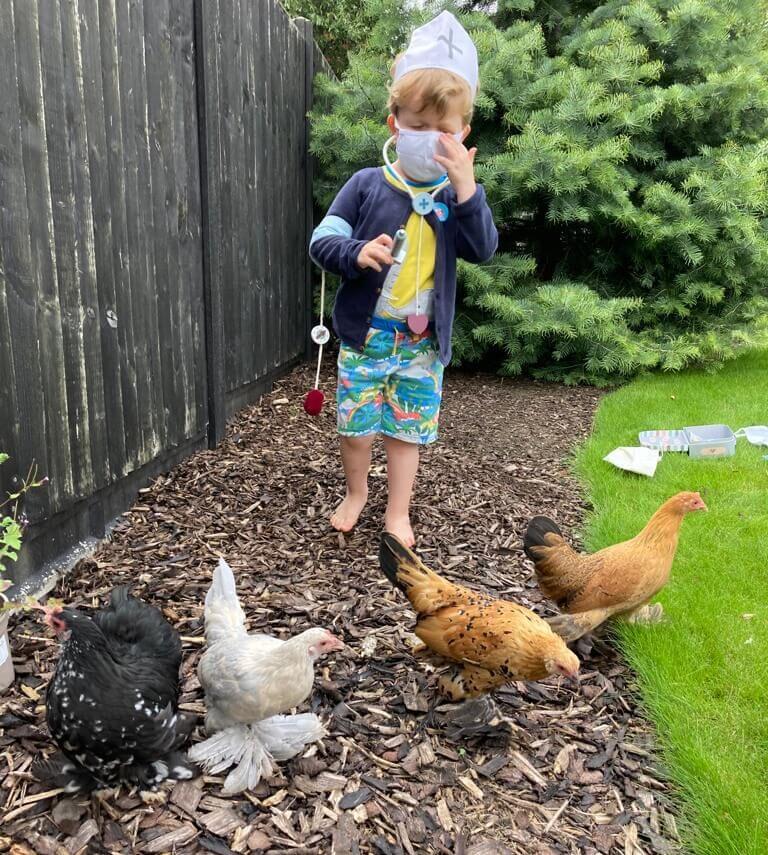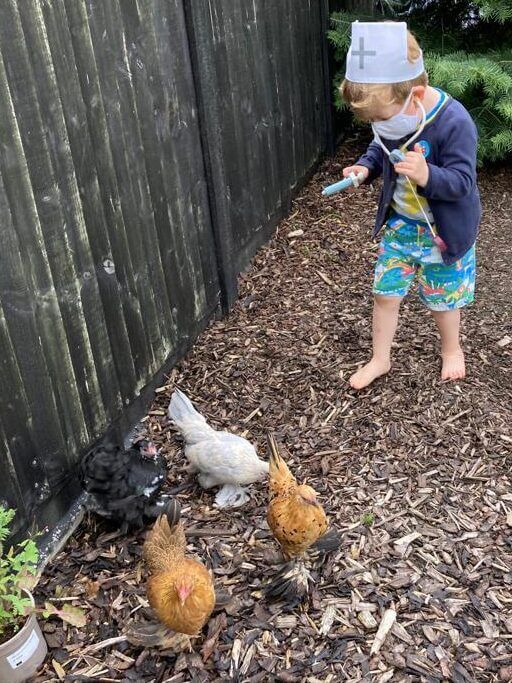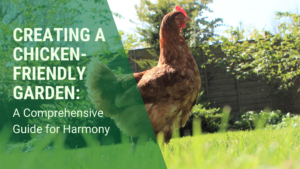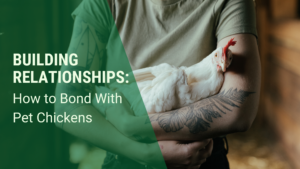The joy of raising chickens and caring for our feathered friends is not without its challenges. Unfortunately, ill health is a fact of life we cannot ignore. In our poultry health guide we discuss what to do when your precious poultry become poorly and how to give them the best chance of bouncing back.
Check out these adorable photos of one of our twins chasing our hens round the garden to give them medical attention! He’s certainly a cute medic – but, of course, he’s not a pro. And, neither are we. Or, presumably, you. We should start this post with an important message – all advice here is based on common sense. It’s not a replacement for veterinary advice or care. If you have any concerns about your flock, please consult a professional. Master ECOnourish isn’t taking any new patients at present….

Be Prepared for Illness in Advance
Acting quickly when your birds fall ill can literally be the difference between life and death. Here’s why:
- Birds are fragile creatures, with a heightened vulnerability to illness due to their unique anatomy and physiology.
- They often don’t show signs of illness until it becomes serious, as this is a survival instinct in the wild.
Therefore, preparation is key. Get ready now, and act quickly to give your chickens the care they deserve!
Register with a Local Poultry Vet
Finding a trustworthy, qualified poultry vet is crucial for the health and happiness of your flock. Be proactive and register with one local to you before any issues arise. You can use the BHWT poultry vet directory to find a poultry-savvy vet near you. Head to https://www.bhwt.org.uk/hen-health/hen-friendly-vets/
Vaccinate your Flock
If you have rehomed ex-commercial hens, they will have been vaccinated as chicks. Check with your breeder whether their chickens have been vaccinated. If you’re breeding your own or sourcing chickens from casual breeders or rehoming situations, consider getting them vaccinated. It’s never a good idea to mix vaccinated and unvaccinated chickens.

Depending on local conditions, your vet may recommend vaccinating for the following diseases:
- Marek’s disease
- Coccidiosis
- Newcastle disease
- Infectious bronchitis
- Infectious bursal disease
- Chicken infectious anaemia
- Salmonellosis
- Reovirus
- Ornithobacterium rhinotracheale
- Infectious avian encephalomyelitis
- Mycoplasma gallisepticum and dynoviae
- Infectious coryza
- Fowl cholera and fowl pox
- Egg drop syndrome
- Gumboro disease
Prepare a Poultry First Aid Kit
Having the necessary tools and medications on hand can be a game-changer in an emergency. Your poultry first aid kit should include:
- Topical antibacterial spray – like Kruuse Antibacterial Blue Spray or Lincoln Purple Spray or Battles Veterinary Antibacterial Spray
- Antimicrobial skin cleanser – like Battles Hibiscrub which works against bacteria, yeast, fungi and viruses.
- Cornfour to stop bleeding – or you can use Kwik Stop Styptic Powder
- Soluble Aspirin – see guidelines and dosage instructions here
- Metacam – do not give with Aspirin
- Probiotics – like AVIPRO or Beryl’s Friendly Bacteria – though our BSF larvae have powerful pre and probiotic qualities too
- Apple cider vinegar
- Olive or vegetable oil
- Epsom salts
- Petroleum jelly – like Vaseline
- Critical Care Formula – like Vetark or CCF
- Enteral (oral) syringes
- Gauze and No-Chew Cohesive Pet Bandages
- Cotton wool and swabs
- Gloves
- Poultry vitamins, calcium drops and electrolytes. You can make your own electrolyte solutions by mixing
- Scissors
- Tweezers
Keep it stocked and secure and in easy reach for when you need it.
Common Poultry Health Complaints
Now, let’s dive into some common health issues poultry can face, along with their signs, symptoms and actions you should take.
Contents
Newcastle Disease
Signs & Symptoms: sneezing, gasping for breath, greenish diarrhoea, drooping wings and twitching
What to Do: Contact your vet immediately! There is no specific treatment, but vaccination can prevent future outbreaks.
Avian Influenza (Bird Flu)
Signs & Symptoms: swollen head, blue discolouration of combs and wattles, decreased egg production, twisted neck, discharge from eyes and nose, head shaking, diarrhoea
What to Do: Begin biosecurity procedures and keep all flocks contained and separated. Notify your vet at once and follow their advice on containment and treatment.
Marek’s Disease
Signs & Symptoms: swollen head, blue discolouration of combs and wattles, decreased egg production, twisted neck, discharge from eyes and nose, head shaking, diarrhoea
What to Do: Begin biosecurity procedures and keep all flocks contained and separated. Notify your vet at once and follow their advice on containment and treatment.
Coccidiosis
Signs & Symptoms: bloody diarrhoea, weakness, and pale combs and wattles
What to Do: Isolate sick birds immediately and use strict biosecurity measures. Keep birds warm and dry. Call your vet and treat with antibiotic medication as prescribed. Follow on with multivitamins and a probiotic.
Vent Prolapse
Signs & Symptoms: “pushed out” vent, visible inner layers of the vent, and possible bleeding and/or discharge.
What to Do: Immediately isolate bird – other birds will peck at the prolapse otherwise. Contact your vet. You can manually reduce the prolapse (push it back in) using gloved fingers and Vaseline. Self-treatment is not a replacement for veterinary attention.
Salpingitis (Lash Egg)
Signs & Symptoms: Lethargy, decreased appetite, swollen abdomen, and the production of strange, rubbery “lash” eggs.
What to Do: A one-off lash egg isn’t always cause for concern. Monitor for other symptoms. If present, call your vet, and monitor other birds for signs of shared symptoms. Taking the hen off lay with a hormone implant can help stop the problem.
Egg-bound Hens
Signs & Symptoms: Straining, discomfort, frequent unsuccessful trips to the nest box.
What to Do: A warm Epsom salt bath followed by putting lubricant (like Vaseline) just inside and around the vent using a gloved finger. Isolate the hen in a warm, dark place and give her privacy. If still unable to pass the egg, arrange an urgent veterinarian visit, keeping the hen warm and comfortable in the meantime.

Egg Yolk Peritonitis
Signs & Symptoms: Lethargy, decreased appetite, difficulty breathing, swollen abdomen, waddling gait and upright stance
What to Do: Another situation for your poultry vet’s attention. Antibiotics will be required to clear the infection and the vet will recommend a hormonal implant to stop the hen laying.
Impacted Crop
Signs & Symptoms: Distended crop that doesn’t empty overnight, sour smell from the beak, and potential weight loss.
What to Do: Stop all access to food but encourage hydration. Isolate hen from the flock. Use a syringe to give 10ml olive or vegetable oil slowly into the side of the beak. Wait 10 minutes then massage the crop to feel for and break down any blockage. Repeat two times over the next 4 hours.
Monitor droppings – if passing nothing, immediately call a vet. If passing some droppings, wait until the next morning. If the crop has not reduced in size, book an appointment with your vet. They may need to surgically remove the blockage.
There are many videos online showing how to manually empty a crop by turning the chicken upside down. This can result in aspiration and suffocation for the chicken and is not recommended unless under veterinary advice.
Salmonellosis
Signs & Symptoms: Thin, shell-less eggs, diarrhoea and dehydration.
What to Do: Immediately contact your vet and isolate the bird. Implement strict biosecurity measures. The vet may recommend antibiotics for the entire flock. Vaccination can help prevent spread.
Bumblefoot
Signs & Symptoms: Limping, swelling, warm to touch, a black spot on the foot pad.
What to Do: If mild, soak the foot in an antiseptic solution. Give pain relief (Metacam or Aspirin in water) under veterinary direction. With sterilised tweezers, remove the scab and squeeze out all pus. Dry the wound, spray with antibacterial spray and dress with gauze and pet bandages. Spray again and redress daily. Encourage exercise. Seek veterinary advice for severe cases or where there’s no improvement.
Infectious Bronchitis
Signs & Symptoms: Coughing and sneezing, interruption to laying habits, chirping, potential gasping, watery mucus from eyes and nose and reduced feed and water intake
What to Do: In chicks, keep them warm by raising the room temperature a few degrees. Introduce biosecurity measures immediately. Keep hens hydrated with electrolytes in drinking water and check with your vet about adding soluble aspirin to treat distress and fever. Secondary bacterial infections can be treated with antibiotics but antibiotics won’t treat IB. Lauric Acid (a powerful antiviral) has been shown to reduce viral load and treat IB – lauric acid is present in BSF larvae and virgin coconut oil.
Infectious Coryza
Signs & Symptoms: Swelling of head, comb, wattles and eyes. Sneezing, lethargy and reduced feed intake and interruption to laying habits. Eyes are often stuck shut with sticky pus which can be in the nose, too. Hens sometimes have a moist area under their wings.
What to do: Call your vet immediately. Early antibiotic treatment can help birds recover. Once recovered, many birds remain carriers, and all flock members should be considered carriers of infectious coryza and not mixed with new flocks during their lifetime.

Wry Neck
Signs & Symptoms: Twisting of the neck, inability to hold their head up straight.
What to Do: Check the chicken’s ears and mouth for bacterial or fungal infection. Give vitamin supplements including Vitamin E and selenium. If no improvement in 24-48 hours, call your vet. It can take up to a month for the condition to reverse – antibiotics may be needed.
Fowl Pox
Signs & Symptoms: White lesions on comb and wattles, depression, and decreased egg production.
What to Do: Contact your vet immediately and follow advice on containment and treatment, including vaccination. Antibiotics can treat the infection. Offer vitamins while recuperating. Treat scabs with antibacterial wound spray and ointment like Vaseline to soften them. Thoroughly clean coops and runs.
Red Mite
Signs & Symptoms: Decreased egg production, restless at night, red marks and small grey pests on the skin and feathers.
What to Do: Thoroughly clean and treat the coop with a recommended red mite treatment. Get a prescription for Exzolt from your vet and add it to drinking water.
Northern Fowl Mite
Signs & Symptoms: Similar to red mite but biting mites can also cause anaemia in extreme cases.
What to Do: Diatomaceous earth in dust baths, nest boxes and under perches. Contact your vet for prescription treatment.

Scaly Leg
Signs & Symptoms: Scaly, crusty leg and foot scales.
What to Do: Purchase Durgall Concentrate. Thoroughly clean out all hen housing. Clean the chicken’s legs with a soft bristled tooth brush or a cloth then try. Mix Dergall with water according to instructions and apply using a spray bottle. Repeat weekly for 2-3 weeks. Apply vaseline to the legs regularly once healing has started – the healing process can take up to a year.
Mycoplasma
Signs & Symptoms: Respiratory signs like coughing, sneezing, wheezing. May also have swollen eyes and reduced laying.
What to Do: Don’t delay, ring your vet straight away! Antibiotics may save your hen.
Fowl Cholera
Signs & Symptoms: Sudden death, green diarrhoea, loss of appetite, darkened head and wattle.
What to Do: Immediate vet visit required, plus extra cleaning to prevent spread.
Pecking Injuries
Signs & Symptoms: Feathers missing, bleeding wounds, timid behaviour.
What to Do: Separate the injured bird immediately and keep isolated. Spray wounds with antibacterial spray, use cornstarch to stop bleeding and dress if necessary. Contact vet if there’s heavy bleeding or signs of infection. Return chicken to the flock when healed.

Soft-Shell Eggs
Signs & Symptoms: Eggs lacking hard exterior shell.
What to Do: Might need increased dietary calcium. Offer calcium drops immediately. Give the hen 10g of Calci Worms daily – the calcium is highly bioavailable. You can buy them direct from us in our shop.
Sour Crop
Signs & Symptoms: Swollen crop, bad smell from the beak, lethargy and poor feeding.
What to Do: Remove all access to food. This needs vet advice fast. Use the impacted crop remedies above but do not delay in calling the vet on this occasion.
Vent Gleet
Signs & Symptoms: Foul-smelling discharge from vent area, red and swollen vent feathers.
What to Do: Give the hen a warm Epsom salt bath for at least 10 minutes. Pat her dry with a clean towel. Apply Canesten cream around and just inside the vent with gloved fingers. Provide probiotics daily and add apple cider vinegar to drinking water. Repeat the Epsom salt bath every 2 days and reapply cream daily until resolved.
Worms
Signs & Symptoms: Weight loss, poor growth, decreased egg production, visible worms around bottom or in stool, dirty bottom, green or yellow droppings.
What to Do: Check droppings regularly. Use a home test kit regularly to check parasitic burden of your flock. Contact your vet for a diagnosis and appropriate wormer treatment.
Final Thoughts and Disclaimer
Remember, any unusual behaviour, sudden changes, or visible discomfort requires investigation. It’s of utmost importance, and is the mark of a responsible and compassionate poultry keeper!
As much as we’d like to help, we at ECOnourish are not veterinary professionals. This post is intended to provide common sense advice, but the most important thing to do in any poultry health situation is to contact a qualified vet for advice immediately.
We’re sending our warmest wishes for the health and happiness of your poultry friends.
Follow us on social media for more valuable poultry health tips, and share your experiences with fellow chicken lovers. Together, we can turn those poorly poultry into happy, healthy hens!
Our Social Media Profiles





